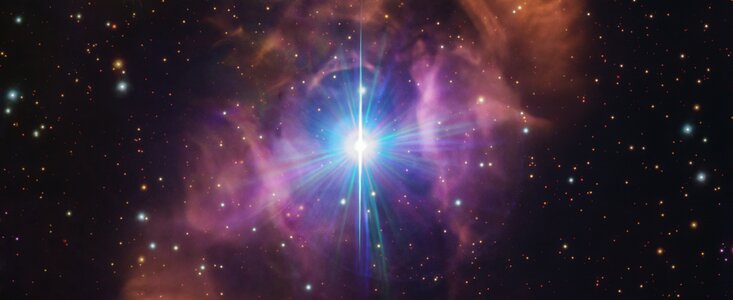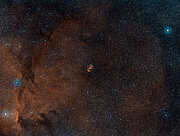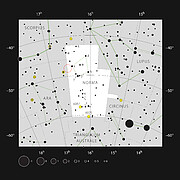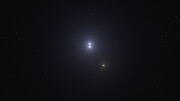Comunicato Stampa
Una nebulosa magnifica con una storia violenta: lo scontro tra le stelle risolve il mistero celeste
11 Aprile 2024

Nell'osservare una coppia di stelle nel cuore di una sorprendente nube di gas e polvere, gli astronomi furono molto sorpresi. Tipicamente le coppie di stelle sono molto simili, come gemelle, ma in HD 148937 una stella appare più giovane e, a differenza dell'altra, magnetica. Nuovi dati dell’ESO (Osservatorio Europeo Australe) suggeriscono che originariamente nel sistema ci fossero tre stelle, finché due di loro non si sono scontrate e si sono fuse. L'evento violento creò la nube circostante e alterò per sempre il destino del sistema.
"Facendo ricerche bibliografiche sono rimasta molto colpita da quanto questo sistema apparisse speciale", afferma Abigail Frost, astronoma dell'ESO in Cile e autrice principale della ricerca pubblicata oggi su Science. Il sistema, HD 148937, si trova a circa 3800 anni luce dalla Terra nella direzione della costellazione Regolo (Norma in latino). È formato da due stelle molto più massicce del Sole e circondate da una bellissima nebulosa: una nube di gas e polveri. “Una nebulosa che circonda due stelle massicce è una vera rarità e ci ha fatto davvero pensare che qualcosa di insolito fosse accaduto in questo sistema. Osservando i dati, la sensazione non ha fatto altro che aumentare”.
"Con un'accurata analisi abbiamo potuto determinare che la stella più massiccia sembra molto più giovane della compagna, il che non ha alcun senso poiché avrebbero dovuto formarsi nello stesso periodo!" aggiunge Frost. La differenza di età – una stella sembra avere almeno 1,5 milioni di anni meno dell’altra – suggerisce che qualcosa abbia ringiovanito la stella più massiccia.
Un altro pezzo del puzzle è la nebulosa che circonda le stelle, nota come NGC 6164/6165. Ha 7500 anni, centinaia di volte più giovane di entrambe le stelle. La nebulosa mostra anche quantità molto elevate di azoto, carbonio e ossigeno. Ciò è sorprendente, poiché questi elementi si trovano di solito nelle profondità della stella, non all'esterno; è come se qualche evento violento li avesse liberati.
Per svelare il mistero, il gruppo di lavoro ha raccolto nove anni di dati provenienti dagli strumenti PIONIER e GRAVITY, entrambi installati sul VLTI (l'interferometro del Very Large Telescope) dell'ESO, situato nel deserto cileno di Atacama. Sono stati utilizzati anche i dati d'archivio dello strumento FEROS presso l'Osservatorio di La Silla dell'ESO.
“Pensiamo che in origine il sistema avesse almeno tre stelle: due di esse vicine tra di loro in un punto dell’orbita e un’altra molto più distante”, spiega Hugues Sana, professore alla KU Leuven in Belgio e ricercatore principale delle osservazioni. “Le due stelle interne si sono fuse in modo violento, creando una stella magnetica e espellendo del materiale che ha creato la nebulosa. La stella più distante ha quindi formato una nuova orbita con la stella appena fusa, ora magnetica, creando il sistema binario che vediamo oggi al centro della nebulosa”.
“Avevo già in mente lo scenario che prevedeva la fusione nel 2017, quando ho studiato le osservazioni della nebulosa ottenute con il telescopio spaziale Herschel dell’Agenzia Spaziale Europea (ESA)”, incalza il coautore Laurent Mahy, attualmente ricercatore senior presso l’Osservatorio Reale del Belgio. “La scoperta di una discrepanza di età tra le stelle suggerisce che questo sia lo scenario più plausibile. È stato possibile mostrarlo solo grazie ai nuovi dati dell’ESO”.
Questo scenario spiega anche perché una delle stelle nel sistema sia magnetica e l’altra no: un’altra caratteristica peculiare di HD 148937 individuata nei dati VLTI.
Inoltre aiuta a risolvere un mistero di vecchia data in astronomia: come le stelle massicce ottengano i loro campi magnetici. Mentre i campi magnetici sono una caratteristica comune delle stelle di piccola massa come il Sole, le stelle più massicce non possono sostenere i campi magnetici con le stesse modalità. Eppure alcune stelle massicce sono effettivamente magnetiche.
Gli astronomi sospettavano da tempo che le stelle massicce potessero acquisire campi magnetici durante la fusione tra due stelle. Ma questa è la prima volta in cui i ricercatori trovano prove così dirette di questo fatto. Nel caso di HD 148937 la fusione deve essere avvenuta di recente. "Si pensa che i campi magnetici non durino molto a lungo nelle stelle massicce, rispetto alla vita della stella, quindi dovremmo aver osservato questo raro evento appena dopo che si è verificato", aggiunge Frost.
L'ELT (Extremely Large Telescope) dell'ESO, attualmente in costruzione nel deserto cileno di Atacama, consentirà ai ricercatori di capire cosa è successo nel sistema in modo più dettagliato e forse rivelerà altre sorprese.
Ulteriori Informazioni
Questo risultato è stato presentato nell'articolo “A magnetic massive star has experienced a stellar merger” pubblicato su Science (www.science.org/doi/10.1126/science.adg7700). L'articolo a stampa verrà pubblicato da Science venerdì 12 aprile 2024, mentre la diffusione online avverrà giovedì 11 aprile 2024 alle 14:00 (U.S. Eastern Time corrispondenti alle 20:00 CEST). Per scaricare la versione finale dell'articolo sotto embargo, si veda il sito: https://www.eurekalert.org/press/scipak/ oppure si contatti scipak@aaas.org prima della fine dell'embargo.
Il progetto ha ricevuto sostegno finanziario dal Consiglio Europeo delle Ricerche (ERC) nell'ambito del programma europeo di ricerca e innovazione Horizon 2020 (accordo numero 772225: MULTIPLES; PI: Hugues Sana).
L'equipe è composta da A. J. Frost (European Southern Observatory, Santiago, Cile [ESO Chile] e Institute of Astronomy, KU Leuven, Belgio [KU Leuven]), H. Sana (KU Leuven), L. Mahy (Royal Observatory of Belgium, Belgio e KU Leuven), G. Wade (Department of Physics & Space Science, Royal Military College of Canada, Canada [RMC Space Science]), J. Barron (Department of Physics, Engineering & Astronomy, Queen’s University, Canada e RMC Space Science), J.-B. Le Bouquin (Université Grenoble Alpes, Centre national de la Recherche Scientifique, Institute de Planétologie et d’Astrophyisique de Grenoble, Francia), A. Mérand (European Southern Observatory, Garching, Germania [ESO]), F. R. N. Schneider (Heidelberger Institut für Theoretische Studien, Germania e Astronomisches Rechen-Institut, Zentrum für Astronomie der Universität Heidelberg, Germania), T. Shenar (The School of Physics and Astronomy, Tel Aviv University, Israele e KU Leuven), R. H. Barbá (Departamento de Física y Astronomía, Universidad de La Serena, Cile), D. M. Bowman (School of Mathematics, Statistics and Physics, Newcastle University, Regno Unito e KU Leuven), M. Fabry (KU Leuven), A. Farhang (School of Astronomy, Institute for Research in Fundamental Sciences, Iran), P. Marchant (KU Leuven), N. I. Morrell (Las campanas Observatory, Carnegie Observatories, Cile) e J. V. Smoker (ESO Chile e UK Astronomy Technology centre, Royal Observatory, Regno Unito).
L'ESO (European Southern Observatory o Osservatorio Europeo Australe) consente agli scienziati di tutto il mondo di scoprire i segreti dell'Universo a beneficio di tutti. Progettiamo, costruiamo e gestiamo da terra osservatori di livello mondiale - che gli astronomi utilizzano per affrontare temi interessanti e diffondere il fascino dell'astronomia - e promuoviamo la collaborazione internazionale per l'astronomia. Fondato come organizzazione intergovernativa nel 1962, oggi l'ESO è sostenuto da 16 Stati membri (Austria, Belgio, Danimarca, Francia, Finlandia, Germania, Irlanda, Italia, Paesi Bassi, Polonia, Portogallo, Regno Unito, Repubblica Ceca, Spagna, Svezia e Svizzera), insieme con il paese che ospita l'ESO, il Cile, e l'Australia come partner strategico. Il quartier generale dell'ESO e il Planetario e Centro Visite Supernova dell'ESO si trovano vicino a Monaco, in Germania, mentre il deserto cileno di Atacama, un luogo meraviglioso con condizioni uniche per osservare il cielo, ospita i nostri telescopi. L'ESO gestisce tre siti osservativi: La Silla, Paranal e Chajnantor. Sul Paranal, l’ESO gestisce il VLT (Very Large Telescope) e il VLTI (Very Large Telescope Interferometer), così come telescopi per survey come VISTA. Sempre a Paranal l'ESO ospiterà e gestirà la schiera meridionale di telescopi di CTA, il Cherenkov Telescope Array Sud, il più grande e sensibile osservatorio di raggi gamma del mondo. Insieme con partner internazionali, l’ESO gestisce APEX e ALMA a Chajnantor, due strutture che osservano il cielo nella banda millimetrica e submillimetrica. A Cerro Armazones, vicino a Paranal, stiamo costruendo "il più grande occhio del mondo rivolto al cielo" - l'ELT (Extremely Large Telescope, che significa Telescopio Estremamente Grande) dell'ESO. Dai nostri uffici di Santiago, in Cile, sosteniamo le operazioni nel paese e collaboriamo con i nostri partner e la società cileni.
La traduzione dall'inglese dei comunicati stampa dell'ESO è un servizio dalla Rete di Divulgazione Scientifica dell'ESO (ESON: ESO Science Outreach Network) composta da ricercatori e divulgatori scientifici da tutti gli Stati Membri dell'ESO e altri paesi. Il nodo italiano della rete ESON è gestito da Anna Wolter.
Links
- Articolo scientifico (preprint; per scaricare la versione finale dell'articolo sotto embargo, si veda il sito: https://www.eurekalert.org/press/scipak/ oppure si contatti scipak@aaas.org prima della fine dell'embargo)
- Fotografie del VLT/VLTI
- Scoprite i dettagli dell'ELT (Extremely Large Telescope) dell'ESO nel sito web dedicato e nella cartella stampa
- Per i giornalisti: iscrivetevi per ricevere i nostri comunicati sotto embargo nella vostra lingua
- Per i ricercatori: avete una storia da raccontare? Inviateci il vostro articolo scientifico
Contatti
Abigail Frost
European Southern Observatory
Santiago, Chile
Tel.: +44 79 8353 9292
E-mail: Abigail.Frost@eso.org
Hugues Sana
KU Leuven
Leuven, Belgium
Tel.: +32 479 50 46 73
E-mail: hugues.sana@kuleuven.be
Laurent Mahy
Royal Observatory of Belgium
Brussels, Belgium
Tel.: +32 476 23 60 06
E-mail: laurent.mahy@oma.be
Bárbara Ferreira
ESO Media Manager
Garching bei München, Germany
Tel.: +49 89 3200 6670
Cell.: +49 151 241 664 00
E-mail: press@eso.org
Lê Binh San PHAM
Communication Officer, Royal Observatory of Belgium
Brussels, Belgium
E-mail: lebinhsan.pham@oma.be
Anna Wolter (press contact Italia)
Rete di divulgazione scientifica dell'ESO
e INAF-Osservatorio Astronomico di Brera
Milano, Italy
Tel.: +39 02 72320321
E-mail: eson-italy@eso.org
Sul Comunicato Stampa
| Comunicato Stampa N": | eso2407it |
| Nome: | HD 148937, NGC 6164, NGC 6165 |
| Tipo: | Milky Way : Star : Grouping : Binary Milky Way : Nebula |
| Facility: | Very Large Telescope Interferometer |
| Instruments: | FEROS, GRAVITY, PIONIER |
| Science data: | 2024Sci...384..214F |
Our use of Cookies
We use cookies that are essential for accessing our websites and using our services. We also use cookies to analyse, measure and improve our websites’ performance, to enable content sharing via social media and to display media content hosted on third-party platforms.
ESO Cookies Policy
The European Organisation for Astronomical Research in the Southern Hemisphere (ESO) is the pre-eminent intergovernmental science and technology organisation in astronomy. It carries out an ambitious programme focused on the design, construction and operation of powerful ground-based observing facilities for astronomy.
This Cookies Policy is intended to provide clarity by outlining the cookies used on the ESO public websites, their functions, the options you have for controlling them, and the ways you can contact us for additional details.
What are cookies?
Cookies are small pieces of data stored on your device by websites you visit. They serve various purposes, such as remembering login credentials and preferences and enhance your browsing experience.
Categories of cookies we use
Essential cookies (always active): These cookies are strictly necessary for the proper functioning of our website. Without these cookies, the website cannot operate correctly, and certain services, such as logging in or accessing secure areas, may not be available; because they are essential for the website’s operation, they cannot be disabled.
Functional Cookies: These cookies enhance your browsing experience by enabling additional features and personalization, such as remembering your preferences and settings. While not strictly necessary for the website to function, they improve usability and convenience; these cookies are only placed if you provide your consent.
Analytics cookies: These cookies collect information about how visitors interact with our website, such as which pages are visited most often and how users navigate the site. This data helps us improve website performance, optimize content, and enhance the user experience; these cookies are only placed if you provide your consent. We use the following analytics cookies.
Matomo Cookies:
This website uses Matomo (formerly Piwik), an open source software which enables the statistical analysis of website visits. Matomo uses cookies (text files) which are saved on your computer and which allow us to analyze how you use our website. The website user information generated by the cookies will only be saved on the servers of our IT Department. We use this information to analyze www.eso.org visits and to prepare reports on website activities. These data will not be disclosed to third parties.
On behalf of ESO, Matomo will use this information for the purpose of evaluating your use of the website, compiling reports on website activity and providing other services relating to website activity and internet usage.
Matomo cookies settings:
Additional Third-party cookies on ESO websites: some of our pages display content from external providers, e.g. YouTube.
Such third-party services are outside of ESO control and may, at any time, change their terms of service, use of cookies, etc.
YouTube: Some videos on the ESO website are embedded from ESO’s official YouTube channel. We have enabled YouTube’s privacy-enhanced mode, meaning that no cookies are set unless the user actively clicks on the video to play it. Additionally, in this mode, YouTube does not store any personally identifiable cookie data for embedded video playbacks. For more details, please refer to YouTube’s embedding videos information page.
Cookies can also be classified based on the following elements.
Regarding the domain, there are:
- First-party cookies, set by the website you are currently visiting. They are stored by the same domain that you are browsing and are used to enhance your experience on that site;
- Third-party cookies, set by a domain other than the one you are currently visiting.
As for their duration, cookies can be:
- Browser-session cookies, which are deleted when the user closes the browser;
- Stored cookies, which stay on the user's device for a predetermined period of time.
How to manage cookies
Cookie settings: You can modify your cookie choices for the ESO webpages at any time by clicking on the link Cookie settings at the bottom of any page.
In your browser: If you wish to delete cookies or instruct your browser to delete or block cookies by default, please visit the help pages of your browser:
Please be aware that if you delete or decline cookies, certain functionalities of our website may be not be available and your browsing experience may be affected.
You can set most browsers to prevent any cookies being placed on your device, but you may then have to manually adjust some preferences every time you visit a site/page. And some services and functionalities may not work properly at all (e.g. profile logging-in, shop check out).
Updates to the ESO Cookies Policy
The ESO Cookies Policy may be subject to future updates, which will be made available on this page.
Additional information
For any queries related to cookies, please contact: pdprATesoDOTorg.
As ESO public webpages are managed by our Department of Communication, your questions will be dealt with the support of the said Department.







